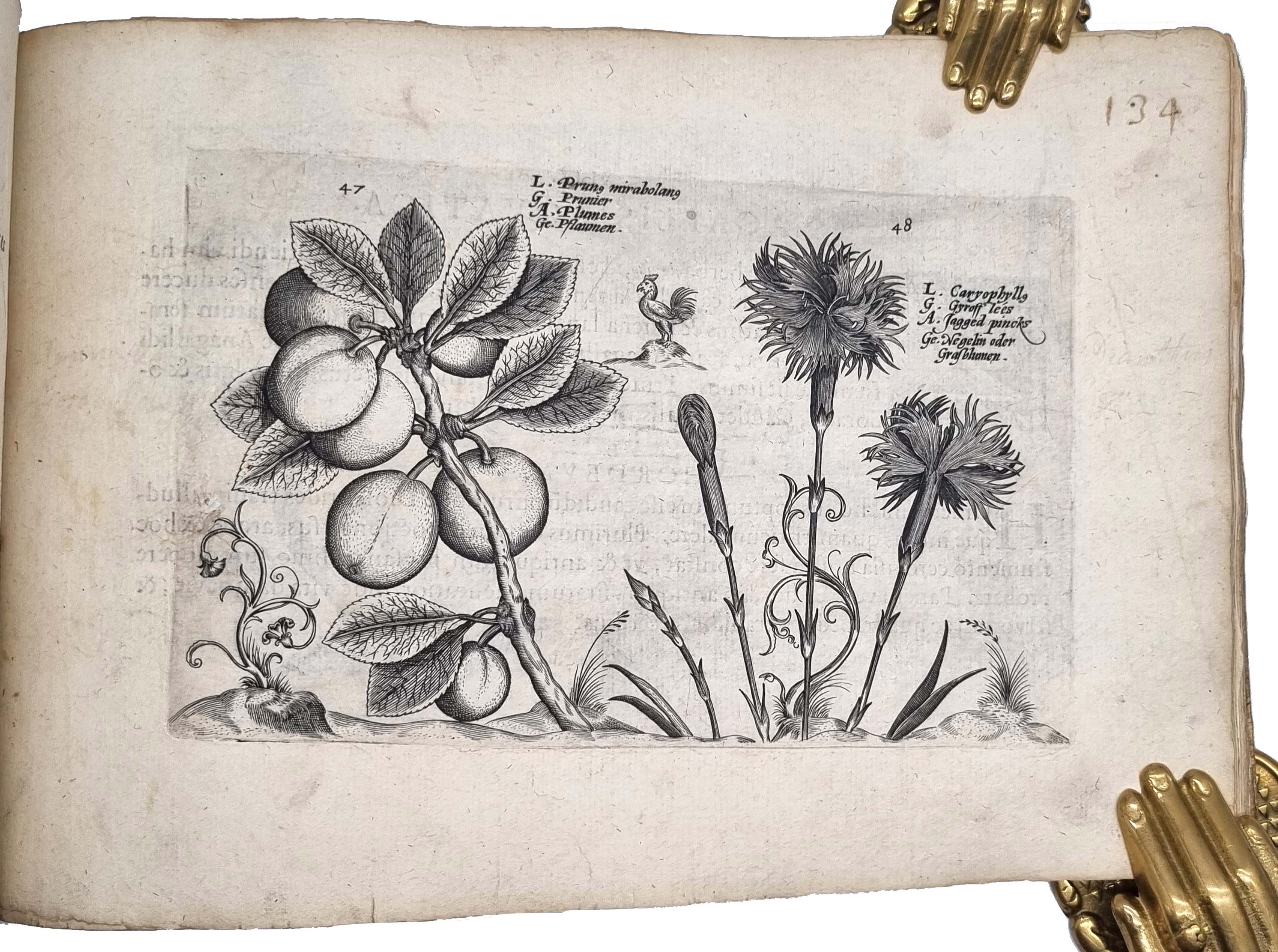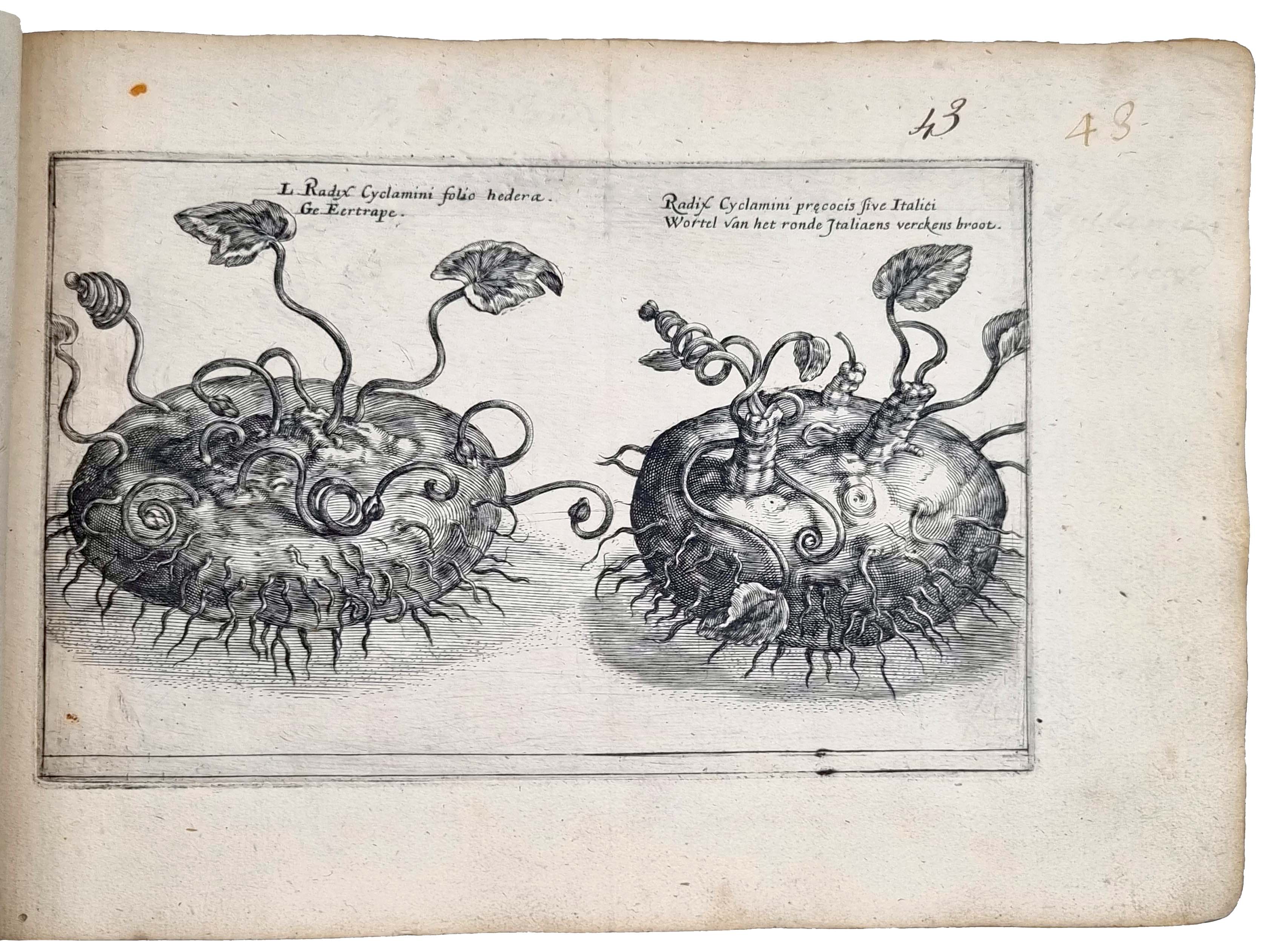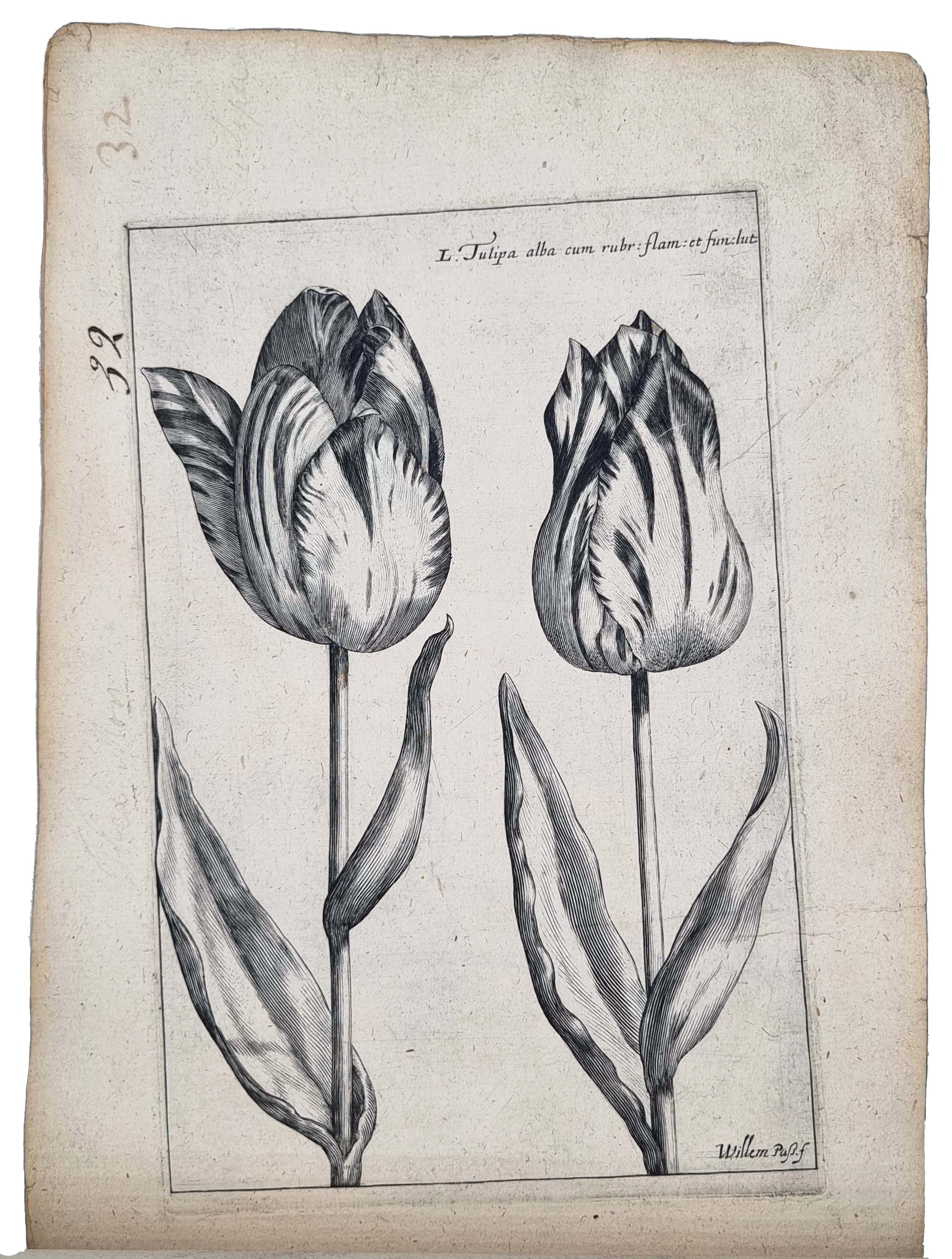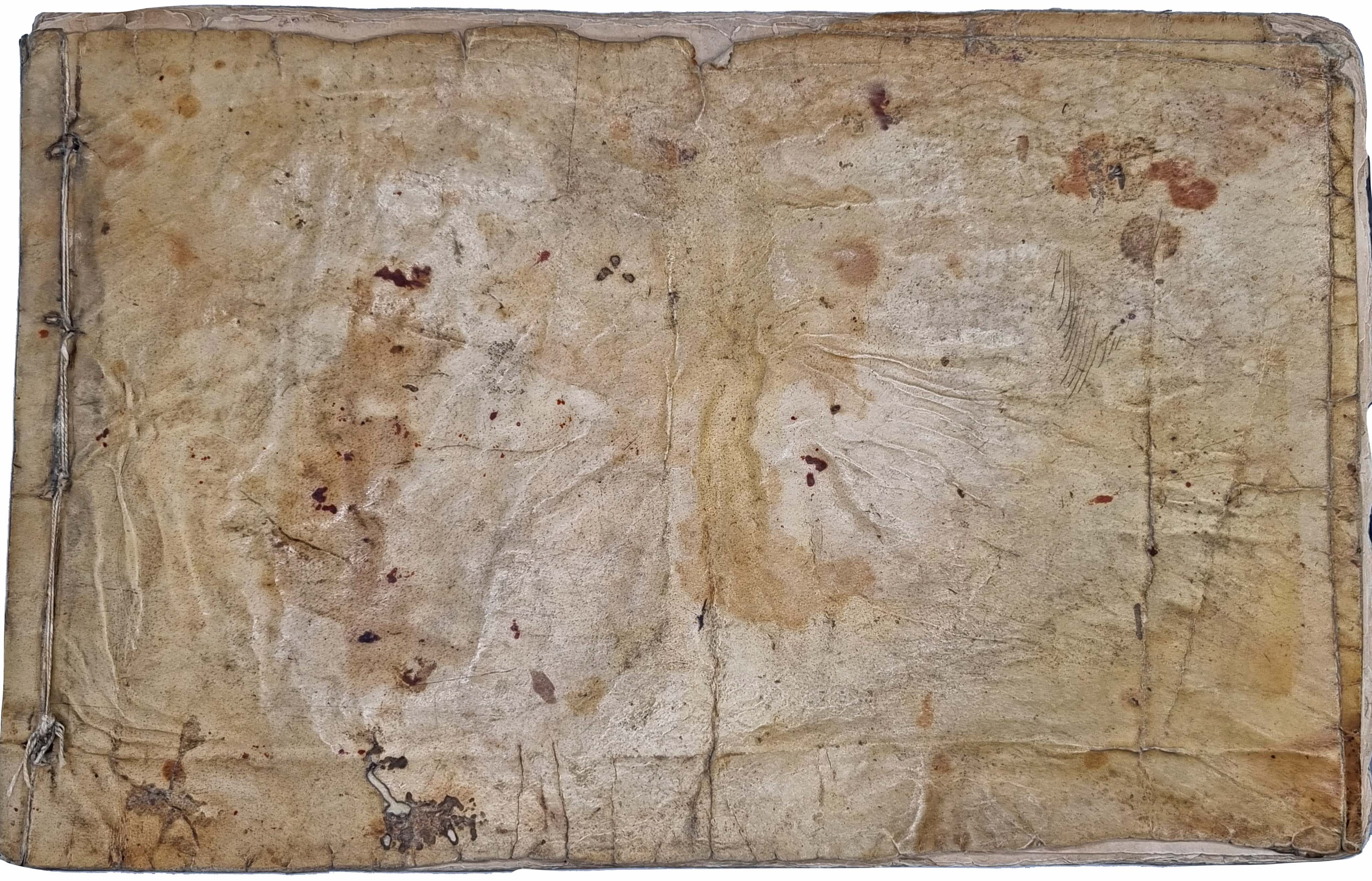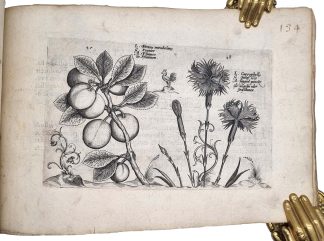PASSE, Crispijn van de
A ROYAL GARDENER’S COPY
Hortus floridus. A garden of flovvers, vvherein very liuely is contained a true and perfect discription of al the flovvers contained in these foure followinge bookes
Utrecht, Salomon de Roy, for Crispian de Passe, 1615£55,000.00
FIRST EDITION thus. Oblong folio. Five parts in one volume. 1) ff. (vii) [(-)1, A-C2], forty three plates of flowers, one of garden scene and one of ‘Epigramma’. 2) ff. (ii) [D1-2], one plate of garden scene, 20 plates of flowers. 3) ff. (iii) [E1-2, F1], twenty eight plates of flowers. 4) ff. (ii) [F2, G1], twelve plates of flowers. 5) ff. (ii) (title and engraved title), sixty one plates of flowers with explanatory text on versos, ff. (i) [G2]. Book one extra illustrated with two additional plates after plate 41, “Bulbus Narcisci marini” and “Radix Cyclamini.” Book three with plate seventeen from the latin version, text on verso, bound out of order, plate 24 re-margined (book four has a fine extra plate 24), extra illustrated with plates 7 and 12 from the winter section, and plate 1 of winter section bound at end. Book four with plates out of order (with plate 1 at end of book 3), extra illustrated with plate 24 from book three, plate 7 from latin edition with text on verso (the correct version is added in book 3). Roman and Italic letter. Text to Parts I-IV in English, text to Altera Pars in Latin. Additional engraved title in Latin tipped in, dated 1614, with mythical figures to sides, portraits in roundels of Dodoens and Clusius, verso of general typographic title with ‘The Book to his Readers’ within typographical border, final leaf G2r within typographical border, Altera pars with letterpress and engraved architectural title with vases of flower to the sides and explanatory text to plates I and II on verso, large historiated, white on black and floriated woodcut initials in explanatory text in Altera pars, ink ownership inscription on plate 7 in part II, “Watts Gardener to his Majesty,” most probably Richard Watts, gardener to Prince George of Denmark at Camden House, St. James’s Palace and Windsor, c. 1700 – 1703, monogram in red crayon on title. Light age yellowing, some light soiling and creasing, small tear in lower blank margin of plate 16 in book two just entering plate, a few very short marginal nicks and chips, early ink pen trials to a couple of plates, mostly confined to margins but some into plate area, plates in parts I-II numbered in ink manuscript both in margins and within plate. A lovely copy with the plates in very fine, rich, and detailed impressions remarkably preserved in contemporary English limp vellum, contained in a modern morocco-backed box by Laurenchet, rubbed, and a bit soiled and creased.
The very rare first English edition of the wonderfully illustrated Hortus Floridus, complete with the rare addition of the Altera pars, and all the plates called for in the contents; it “was without question the most popular florilegium ever published,” An Oak Spring Flora. The first edition appeared in 1614 in Latin and proved so popular that it was almost immediately followed by French, Dutch, and English editions. The introduction is enlarged with details on how to colour the plates. One of the earliest florilegia, the Hortus Floridus contains very fine realistic and delicate prints created by Crispin van de Passe, a member of a famous family of Dutch artists.
The book is divided into four sections, each corresponding with one of the seasons and prefaced with an engraving of a model garden. Most of the flowers shown are tulips, hyacinths, crocuses and other bulb plants, the new enthusiasm of the increasingly prosperous Dutch citizenry. Van de Passe’s work both documented and stimulated the Dutch passion for bulbs, which eventually led to the ‘tulipomania’ of 1636 – 1637, when speculation in tulip bulbs led to a financial crash.
Unlike earlier botanical works in which the plants were shown by themselves, van de Passe placed his specimens in a natural environment, often accompanied by insects and animals that provide a narrative element to the images. The ground level perspective of the illustrations reflects the tradition of Dutch landscape painting, characterized by atmospheric and panoramic views of the flat Dutch landscape set against a low horizon, and dominated by a vast and expansive sky. The first four parts include 106 plates by Crispin De Passe, the flowers being classified per season rather than per species.
“The plates are landscapes in miniature, embellished with animals and insects, and with the plants shown growing from the ground with a vigorous naturalism. The emphasis of the publication is on the common garden flowers, with a preponderance of spring bulbs.” Gill Saunders.
These engravings cannot be seen as solely botanical illustrations, as they also echo the artistic grammar of contemporary Flemish and Dutch painting. The following fifth part includes 61 plates featuring 120 numbered fruit trees and medical plants. According to Franken, these last series were executed by a German engraver rather than by a member of the De Passe family. The quality of the engraving is exceptionally fine and delicate and where they are preserved in fine impressions, as here, are masterpieces of horticultural art.
“By uniting scientific illustration and the genre of the still-life in Hortus Floridus, van de Passe made available a precious repertory of floral images for artists such as van der Ast, Ambrosius Bosschaert and Roelandt Savery. Some of the plates of single flowers were copied for other botanical works.” Oak Spring Flora, 12. A wonderful copy, with the plates in very fine impression, of the exceptionally rare English edition in contemporary limp vellum.
STC 19459. ESTC S110319. Oak Spring Flora, 12 .Saunders, Picturing Plants, 36-37; Nissen BBI 1494. Hunt 199; Savage, ‘The Hortus Floridus’, Transactions of the Bibliographical Society, Second Series, vol. IV, (1923) pp.181-205.In stock


